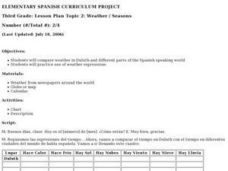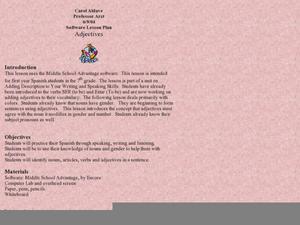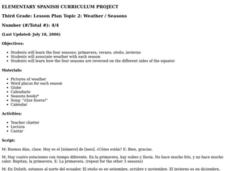Curated OER
Froggy Gets Dressed
Froggy wants to know: what are you wearing? Lead young Spanish learners through a review of weather-related terms before reading the popular children's book Froggy Gets Dressed. Then, using a froggy puppet, discuss what you're wearing...
Curated OER
Pastimes
Use realia (like soccer balls, pictures of soccer players, jerseys, etc.) to interest your young Spanish speakers! Teach them basic sports related vocabulary and encourage choral responses from your youngsters.
Curated OER
Flip Libdub
How do you translate songs from English to Spanish? Have your intermediate learners work in groups to choose a song, translate it, and record themselves singing the lyrics. Provide your class with more time or recommend some out of class...
Curated OER
Weather/ Seasons Chart
After reviewing weather expressions with your Spanish scholars, have them do some research: what is the weather like in different parts of the world? They can choose up to four different cities to compare with the local weather of their...
Curated OER
Family
Use pictures of families to help young Spanish learners acquire family related vocabulary. Bring in pictures of your family and encourage kids to bring in pictures of theirs. Then after introducing the target vocabulary, draw a diagram...
Curated OER
Software Lesson Plan
While this plan uses Middle School Advantage software by Encore, you could still use the attached worksheet if you don't have access to the program. Encourage Spanish learners to work with different adjectives and write descriptive...
Curated OER
Colors and Fruit
Review colors in Spanish by presenting different photographs and asking your charges to identify the colors in each picture. Consider bringing in pictures from Spain, Mexico, or another Spanish-speaking country to make the activity more...
Curated OER
Animals
Designed for a third grade Spanish class, this mini-instructional activity offers a look at animals and the sounds they make. First, the teacher will review the different sounds that animals make. Then, the whole class will read Miau and...
Curated OER
Exploring Numbers
Start this short plan by greeting your youngsters in Spanish. In this 15 or 20 minute lesson, you'll review numbers one through 10 before working on numbers up to 20. Use pictures to give learners something visual to count. If time, the...
Curated OER
Animals and Their Personalities
Now that your young Spanish speakers know the Spanish words for common animals, discuss what each animal eats and their personalities. It's great that the class starts by looking at an animal, identifying a characteristic or trait it...
Curated OER
Diminutivos
There are several reasons why Spanish speakers use the diminutive form. Not only is it used to indicate size, but it can also indicate affection. This plan, while not incredibly detailed, does provide some great questions for...
Curated OER
Future Actions
How do you conjugate a reflexive verb? This plan suggests reading a children's book to your intermediate Spanish speakers. Follow the reading with a PowerPoint slide show that presents reflexive verbs, a sentence using the verb, and a...
Curated OER
Animal Noises
The Spanish song, Vengan a Ver Mi Granja, provides young language learners an opportunity to expand their vocabulary. After listening to the sounds, class members name the animals and their habitats, construct puppets of the animals, and...
Curated OER
Mi Perro Perdido (My Lost Dog)
Students receive a map of the school and a set of directions in Spanish for each pair that lead them to a specific place on campus. They use the directions and maps to leads them to pieces of colored paper that have been hidden. Each...
Curated OER
Cool Cats Counting
First graders count and sequence the numbers from one through ten in English and Spanish using the book "Cool Cats Counting." They identify and count the animals in the book, create rhyming words, and construct a counting mobile.
Curated OER
Weather/ Seasons
Read Un dia de lluvia with your young Spanish speakers. The firs time through, everyone listens intently. The second time, pass out props that correlate with the story (like pictures of trees and bird). Then, while the teacher reads, the...
Curated OER
Seasons
¿Qué temperado es? Discuss the seasons with your young Spanish learners. Read a book that correlates with whatever season it currently is where you are located. This plan suggests one from Barron's, although any seasonal book will do....
Curated OER
En mi familia
Read En mi familia and discuss families with your young Spanish learners. Who is in their family? What are the roles of each person there? Does one person generally cook? Youngsters learn the vocabulary for activities that people do in...
Curated OER
Describing the Planets
Young Spanish language learners review the names of each planet. Then, in pairs, they work to complete the chart provided. What is the composition of each planet? What is the color? They learn how to describe the planets.
Curated OER
Describing People
With a variety of pictures, fourth grade Spanish language learners will review adjectives by describing the appearance of the people in the pictures. You will need to bring in the pictures, and consider creating a word bank of adjectives...
Curated OER
Explore Fish
Read Animals Called Fish with your young Spanish language learners and talk about the different parts of a fish. After teaching terms like huesos, columna vertebral, aletas, escamas, etc, Learners will draw a picture of a fish and label...
Curated OER
Describe Yourself!
Who are you? Where are you from? Teach young Spanish language learners how to identify themselves and where they're from. They draw a picture of themselves to help develop vocabulary for this activity.
Curated OER
Cities and Countries Around the World
Briefly introduce your young Spanish speakers to different cities around the world. Identify the country they are located in, what the people are called from those countries, and the country's location on a class map. Make sure to use...
Curated OER
Cities and Countries
Part of studying Spanish is learning about the customs, food, and traditions of other countries. Use the links provided (and some of your own) to study Venezuela, Uruguay, Guatemala, and Peru. Elementary learners will get a glimpse of...
Other popular searches
- Spanish Grammar Worksheets
- Spanish Lesson Plans
- Spanish Christmas Activities
- Spanish Language
- Spanish Colors
- Spanish Explorers
- Spanish Literature
- Spanish Weather Activities
- Spanish Culture
- Spanish Speaking Countries
- Spanish Body
- Spanish American War

























